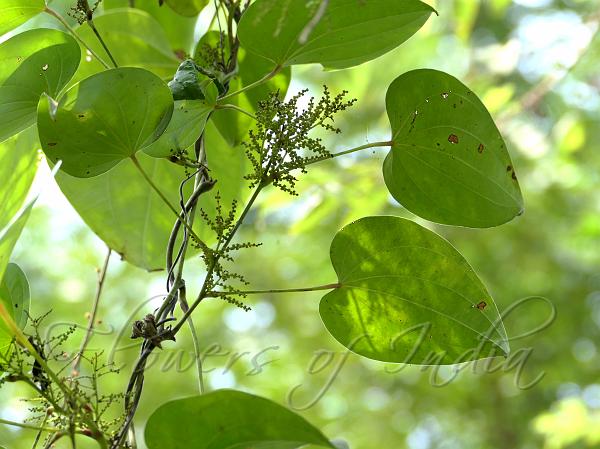|
| Indian Wild Yam |
|

|

| File size | 678921 |
| Original date | 11/4/23 12:30 PM |
| Resolution | 5472 x 3648 |
| Flash | Flash did not fire, auto |
| Focal length | 67.72mm |
| Exposure time | 1/200s |
| Aperture | 4.0 |
| Focus Distance | |
| Metering Mode | Spot |
| Camera make | Panasonic |
| Camera model | DC-FZ10002 |
| Sensor type | OneChipColorArea |
|
|
|
|
Photo: |
Botanical name: Dioscorea wallichii Family: Dioscoreaceae (Yam family)
Synonyms: Dioscorea wallichii var. christiei, Dioscorea wallichii var. vera
Synonyms: Dioscorea wallichii var. christiei, Dioscorea wallichii var. vera
Indian Wild Yam is a climber with stem twining to
the right, smooth or scarcely prickly towards the base. Leaves are up
to 12 x 12 cm, round, bluntly tapering, widely heart-shaped at base;
nerves 12 pairs from the base, hairless, intercostae parallel;
leaf-stalk up to 14 cm long. Flowers are borne in slender spikes 7-10
cm long, 3-6 together at nodes on 30-40 cm long flower-cluster-stalk;
bracts and bracteoles ovate, tapering. Male tepals are 1 x 1 mm, ovate,
pointed; stamens 6. Capsules (immature) are not reflexed, drying
blackish, hairless, base truncate, tip notched toflat; wings 1.7-2.2
cm wide. Tubers are palmately branched, cylindric. Round capsules
contain flat, brown seeds with a thin, marginal wing. The tubers can be
eaten after boiling and washing. Indian Wild Yam is found in Western Ghats,
East Himalaya, China and SE Asia.
| Identification credit: Dinesh Valke | Photographed in Kolshet, Maharashtra. |
• Is this flower misidentified? If yes,